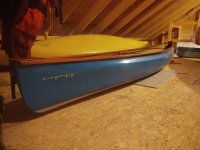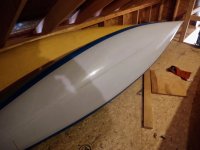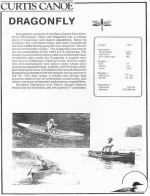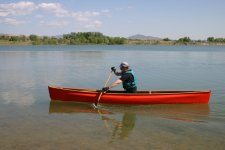-
Happy Winter Solstice! 🌇🌃
You are using an out of date browser. It may not display this or other websites correctly.
You should upgrade or use an alternative browser.
You should upgrade or use an alternative browser.
Colden DragonFly for sale - SOLD
- Thread starter yellowcanoe
- Start date
Well, I don't have a Colden Dragonfly but I do own a Kevlar Curtis Dragonfly and a Black Gold Bell Wildfire.Wow. Gorgeous. Always wondered about this boat. How does handling compare to a composite wildfire?
In my opinion the Dragonfly is faster. The Dragonfly is an inch narrower at the waterline and half a foot longer. Both are quite maneuverable with substantial rocker. The Wildfire feels a bit more user-friendly as it has a more elliptical hull bottom contour while the Dragonfly trends toward a more rounded bottom.
Believe pblanc…that’s a very accurate comparison.
The deeper depth and rounder bottom on the Fly work better on rivers but as a user friendly boat the Wild with its flatter bottom is more forgiving.. That said I have a friend that lowered the seat on her Curtis Dragonfly and it does not eject her: she can't kneel. I have both boats and there really is no need for both now. Not doing many rivers.Wow. Gorgeous. Always wondered about this boat. How does handling compare to a composite wildfire?
I have seen Kim's Dragonfly and yes, it is an extremely handsome boat with beautiful cherry wood trim. The Curtis Dragonfly is no slouch either. Here is a friend paddling a fiberglass Curtis Dragonfly of mine.
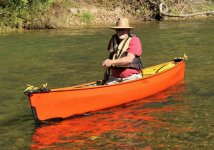
And indeed they are pretty rare. I don't know how many Colden Dragonflies Paul Meyer made before he ceased operations. It is said that Dave Curtis built and sold only 85 Dragonflies.

And indeed they are pretty rare. I don't know how many Colden Dragonflies Paul Meyer made before he ceased operations. It is said that Dave Curtis built and sold only 85 Dragonflies.
I heard the same rumor. I know Paul built at least two before going back to his more lucrative job full time. I have always liked the orange of the Curtis.
The Dragonfly was originally spec'ed, designed and manufactured for one now legendary paddler, Harold Deal. As a highly decorated whitewater canoe racer, one of the recognized founders of flat water freestyle, and and a very experienced wilderness tripper, Harold is the all-around best paddler I've ever known.
Harold sent me a very long and detailed history of the Dragonfly in 2011, which had also been reviewed and contributed to by Dave Curtis, and I've talked to both of them at length, as well as Dave Yost, about the development of the Dragonfly. Because Harold put a copyright notice on his 2011 write-up, I'm reluctant to post it. However, I'll use my own words to summarize some of the key points about the Dragonfly's history.
Harold had been racing in all whitewater classes in the early 1980's, but was particularly interested in the "combined" class, in which the same racer would combine his or her scores in the slalom race and the downriver race. In those days, it was not uncommon for the slalom and downriver races to be held in two different locations, and for the downriver race to have long sections of flat water and even portages. Often, the paddler would use different canoes for the slalom and downriver races.
Harold was interested in developing one canoe that could be optimized as much as possible for both slalom and downriver racing. This combination of attributes later made the Dragonfly very useful as wilderness tripping canoe, especially on long trips where the paddler would face rivers, rapids, big swaths of lakes, and intervening portages.
Beginning around 1982, Harold began working with Dave Yost and Dave Curtis to develop this special canoe. The idea began with basically a lake canoe design with touring stems. The canoe was narrowed and bottom rounded to reduce drag, increase speed and promote vertical strokes. The depth was set at the then maximum for slalom racing, 14".
One very important characteristic Harold wanted was stable secondary stability for the radical J-leans necessary for turns in whitewater slalom gates. However, he also wanted narrow gunwales. Bubbled tumblehome sides, as Dave Yost was then designing, provided narrow gunwales but not much secondary stability, so they were ruled out. Finally, Harold didn't want to lay down the gunwales right to the rails to do snappy turns, as in flat water freestyle, because fully laying down the gunwale in whitewater would allow waves to slop into the canoe.
This trilemma—narrow gunwales, solid secondary stability, and not needing to rail the canoe for turns—was solved by Harold, Yost and Curtis, working as a team, by developing a flared hull that sharply transitioned into what is now called "shouldered tumblehome" a "shouldered gunwale" or simply a "shoulder". Harold could heel the canoe over onto the stable flare below the shoulder, but have the tucked-in gunwale itself remain clear above the water.
Because the canoe retained essentially lake touring stems, Harold developed a style to turn into and out of slalom gates by heeling the canoe to the off-side rather than the on-side—that is, to do carved turns (post turns) rather than pivot turns (axle turns). This style of turning was common in flat water racing canoes and is now not uncommon in hard-chined whitewater canoes.
The Dragonfly was the first commercially available canoe to implement full shoulders, "going public" at the at the Whitewater Open Canoe National Championships at Nantahala in 1984. (Although Mike Galt's Lotus Caper, having less radically tucked in gunwales, was actually put on the market slightly earlier. Dave Curtis suspects Galt saw the plug of the Dragonfly in 1983 at the Canoe Specialists Solo Symposium on the White River, Arkansas.)
In my opinion, the Dragonfly was the first, and only one of two canoes, that have ever been designed with combined class racing in mind. The second was the Crossfire, which had a symmetrical and an asymmetrical version, developed by the same team of Deal, Yost and Curtis, but which was never really commercialized. A third canoe is the Hemlock SRT, designed solely by Harold Deal, which was designed for wilderness river tripping but which Harold also raced in downriver class whitewater. As Dave Curtis has summarized: "The Dragonfly was designed as combined class racing canoe that ended up being very useful as a wilderness tripping canoe, while the SRT was designed as a river tripping canoe that ended up being useful as a downriver class racing canoe."
I own a composite Bell Wildfire and an SRT and have paddled the Dragonfly briefly long ago. From everything I've recited above about the Dragonfly's specs, there is no doubt in my mind that it is longer, narrower, faster, deeper and more capacious for gear than a Wildfire, but also with somewhat less initial stability. It would also be the more capable whitewater canoe.
Harold sent me a very long and detailed history of the Dragonfly in 2011, which had also been reviewed and contributed to by Dave Curtis, and I've talked to both of them at length, as well as Dave Yost, about the development of the Dragonfly. Because Harold put a copyright notice on his 2011 write-up, I'm reluctant to post it. However, I'll use my own words to summarize some of the key points about the Dragonfly's history.
Harold had been racing in all whitewater classes in the early 1980's, but was particularly interested in the "combined" class, in which the same racer would combine his or her scores in the slalom race and the downriver race. In those days, it was not uncommon for the slalom and downriver races to be held in two different locations, and for the downriver race to have long sections of flat water and even portages. Often, the paddler would use different canoes for the slalom and downriver races.
Harold was interested in developing one canoe that could be optimized as much as possible for both slalom and downriver racing. This combination of attributes later made the Dragonfly very useful as wilderness tripping canoe, especially on long trips where the paddler would face rivers, rapids, big swaths of lakes, and intervening portages.
Beginning around 1982, Harold began working with Dave Yost and Dave Curtis to develop this special canoe. The idea began with basically a lake canoe design with touring stems. The canoe was narrowed and bottom rounded to reduce drag, increase speed and promote vertical strokes. The depth was set at the then maximum for slalom racing, 14".
One very important characteristic Harold wanted was stable secondary stability for the radical J-leans necessary for turns in whitewater slalom gates. However, he also wanted narrow gunwales. Bubbled tumblehome sides, as Dave Yost was then designing, provided narrow gunwales but not much secondary stability, so they were ruled out. Finally, Harold didn't want to lay down the gunwales right to the rails to do snappy turns, as in flat water freestyle, because fully laying down the gunwale in whitewater would allow waves to slop into the canoe.
This trilemma—narrow gunwales, solid secondary stability, and not needing to rail the canoe for turns—was solved by Harold, Yost and Curtis, working as a team, by developing a flared hull that sharply transitioned into what is now called "shouldered tumblehome" a "shouldered gunwale" or simply a "shoulder". Harold could heel the canoe over onto the stable flare below the shoulder, but have the tucked-in gunwale itself remain clear above the water.
Because the canoe retained essentially lake touring stems, Harold developed a style to turn into and out of slalom gates by heeling the canoe to the off-side rather than the on-side—that is, to do carved turns (post turns) rather than pivot turns (axle turns). This style of turning was common in flat water racing canoes and is now not uncommon in hard-chined whitewater canoes.
The Dragonfly was the first commercially available canoe to implement full shoulders, "going public" at the at the Whitewater Open Canoe National Championships at Nantahala in 1984. (Although Mike Galt's Lotus Caper, having less radically tucked in gunwales, was actually put on the market slightly earlier. Dave Curtis suspects Galt saw the plug of the Dragonfly in 1983 at the Canoe Specialists Solo Symposium on the White River, Arkansas.)
In my opinion, the Dragonfly was the first, and only one of two canoes, that have ever been designed with combined class racing in mind. The second was the Crossfire, which had a symmetrical and an asymmetrical version, developed by the same team of Deal, Yost and Curtis, but which was never really commercialized. A third canoe is the Hemlock SRT, designed solely by Harold Deal, which was designed for wilderness river tripping but which Harold also raced in downriver class whitewater. As Dave Curtis has summarized: "The Dragonfly was designed as combined class racing canoe that ended up being very useful as a wilderness tripping canoe, while the SRT was designed as a river tripping canoe that ended up being useful as a downriver class racing canoe."
I own a composite Bell Wildfire and an SRT and have paddled the Dragonfly briefly long ago. From everything I've recited above about the Dragonfly's specs, there is no doubt in my mind that it is longer, narrower, faster, deeper and more capacious for gear than a Wildfire, but also with somewhat less initial stability. It would also be the more capable whitewater canoe.
Geez that’s a hard sell tactic there Glenn.
I'm not the seller and that's not my intent. While I hope Kim sells her Dragonfly to an appreciative buyer, I was simply using the ad to document some canoe history that not many people outside of Deal, Curtis and Yost know.
Is it suitable for a 225-lb paddler?
I'm sure it is as a day paddling canoe, but obviously a 225 pounder couldn't carry as much gear as 160 lb. Harold Deal for a wilderness trip.
I'm not the seller and that's not my intent. While I hope Kim sells her Dragonfly to an appreciative buyer, I was simply using the ad to document some canoe history that not many people outside of Deal, Curtis and Yost know.
I'm sure it is as a day paddling canoe, but obviously a 225 pounder couldn't carry as much gear as 160 lb. Harold Deal for a wilderness trip.
I’m just razzing ya a little. It’s a beautiful boat and I really appreciate the history lesson. I’ve been reflecting on how much shopping for a canoe involved researching the history of modern canoe design. I’m better for the reading too, except now my answers to other folks about canoes are getting a lot longer. I’m on the verge of inducing MEGO.
@yellowcanoe i guess I’m a little sad you’re selling it, but I get it. Good luck with the sale, and I hope it finds the right home!
yes. I just find in old age with a knee replacement and no kneecap I can't kneel.My Wildfire is friendlier for sitting. It handles 300 lbs of me and gear for an extended trip just fine. I used to use it on Ozark Rivers and Maine Rivers to class 2 with a week of gear.Geez that’s a hard sell tactic there Glenn. Is it suitable for a 225-lb paddler? But alas I’ve committed to a Phoenix and cannot afford both.
Thanks for the history lesson Glenn. I've never paddled a Dragonfly, but I purchased an SRT two years ago. There is a learning curve involved with paddling a boat designed to carve turns by heeling to the outside of the turn. It was interesting to learn about the history and design characteristics of these craft.
I’m just razzing ya a little. It’s a beautiful boat and I really appreciate the history lesson. I’ve been reflecting on how much shopping for a canoe involved researching the history of modern canoe design. I’m better for the reading too, except now my answers to other folks about canoes are getting a lot longer. I’m on the verge of inducing MEGO.
@yellowcanoe i guess I’m a little sad you’re selling it, but I get it. Good luck with the sale, and I hope it finds the right home!
Glen, I have had a Curtis Dragonfly since 1988 and would like to learn more about it's history. Can you connect me to Harold Deal so I might obtain a copy of the history?
Bill, the last time I was in contact with Harold he was recovering from a long illness. I don't feel comfortable, especially in my current administrative position here, in giving out people's private contact information. Other folks here may have his contact info and maybe they will contact you via private conversation.
Dave Curtis is public, knows everything there is to know about the Dragonfly, and perhaps would be willing to discuss or email any information he may have.
Finally, I summarized the essence of Harold's historical account re the Dragonfly, leaving out just some technical and personal details and his discussion of the Crossfire, Shaman and SRT.
Similar threads
- Replies
- 95
- Views
- 14K
- Replies
- 5
- Views
- 922

